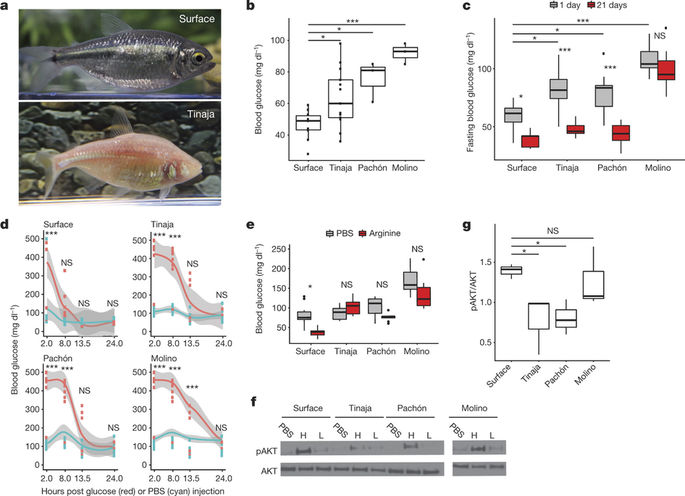Our official English website, www.x-mol.net, welcomes your feedback! (Note: you will need to create a separate account there.)
Insulin resistance in cavefish as an adaptation to a nutrient-limited environment
Nature ( IF 64.8 ) Pub Date : 2018-03-21 , DOI: 10.1038/nature26136 Misty R. Riddle , Ariel C. Aspiras , Karin Gaudenz , Robert Peuß , Jenny Y. Sung , Brian Martineau , Megan Peavey , Andrew C. Box , Julius A. Tabin , Suzanne McGaugh , Richard Borowsky , Clifford J. Tabin , Nicolas Rohner
Nature ( IF 64.8 ) Pub Date : 2018-03-21 , DOI: 10.1038/nature26136 Misty R. Riddle , Ariel C. Aspiras , Karin Gaudenz , Robert Peuß , Jenny Y. Sung , Brian Martineau , Megan Peavey , Andrew C. Box , Julius A. Tabin , Suzanne McGaugh , Richard Borowsky , Clifford J. Tabin , Nicolas Rohner

|
Periodic food shortages are a major challenge faced by organisms in natural habitats. Cave-dwelling animals must withstand long periods of nutrient deprivation, as—in the absence of photosynthesis—caves depend on external energy sources such as seasonal floods. Here we show that cave-adapted populations of the Mexican tetra, Astyanax mexicanus, have dysregulated blood glucose homeostasis and are insulin-resistant compared to river-adapted populations. We found that multiple cave populations carry a mutation in the insulin receptor that leads to decreased insulin binding in vitro and contributes to hyperglycaemia. Hybrid fish from surface–cave crosses carrying this mutation weigh more than non-carriers, and zebrafish genetically engineered to carry the mutation have increased body weight and insulin resistance. Higher body weight may be advantageous in caves as a strategy to cope with an infrequent food supply. In humans, the identical mutation in the insulin receptor leads to a severe form of insulin resistance and reduced lifespan. However, cavefish have a similar lifespan to surface fish and do not accumulate the advanced glycation end-products in the blood that are typically associated with the progression of diabetes-associated pathologies. Our findings suggest that diminished insulin signalling is beneficial in a nutrient-limited environment and that cavefish may have acquired compensatory mechanisms that enable them to circumvent the typical negative effects associated with failure to regulate blood glucose levels.
中文翻译:

洞穴鱼的胰岛素抵抗是对营养有限环境的适应
周期性食物短缺是自然栖息地生物面临的主要挑战。穴居动物必须承受长期的营养缺乏,因为在没有光合作用的情况下,洞穴依赖于季节性洪水等外部能源。在这里,我们展示了墨西哥 tetra 的洞穴适应种群 Astyanax mexicanus,与适应河流的种群相比,血糖稳态失调并且具有胰岛素抵抗性。我们发现多个洞穴种群的胰岛素受体发生突变,导致体外胰岛素结合降低并导致高血糖症。携带这种突变的地表-洞穴杂交的杂交鱼比非携带者重,经过基因工程携带突变的斑马鱼增加了体重和胰岛素抵抗。在洞穴中,较高的体重可能是应对稀少食物供应的一种策略。在人类中,胰岛素受体的相同突变会导致严重的胰岛素抵抗和寿命缩短。然而,洞穴鱼的寿命与表面鱼类相似,并且不会在血液中积累通常与糖尿病相关病理进展相关的晚期糖基化终产物。我们的研究结果表明,减少的胰岛素信号在营养有限的环境中是有益的,并且洞穴鱼可能已经获得了补偿机制,使它们能够规避与未能调节血糖水平相关的典型负面影响。胰岛素受体的相同突变会导致严重的胰岛素抵抗和寿命缩短。然而,洞穴鱼的寿命与表面鱼类相似,并且不会在血液中积累通常与糖尿病相关病理进展相关的晚期糖基化终产物。我们的研究结果表明,减少的胰岛素信号在营养有限的环境中是有益的,并且洞穴鱼可能已经获得了补偿机制,使它们能够规避与未能调节血糖水平相关的典型负面影响。胰岛素受体的相同突变会导致严重的胰岛素抵抗和寿命缩短。然而,洞穴鱼的寿命与表面鱼类相似,并且不会在血液中积累通常与糖尿病相关病理进展相关的晚期糖基化终产物。我们的研究结果表明,减少的胰岛素信号在营养有限的环境中是有益的,并且洞穴鱼可能已经获得了补偿机制,使它们能够规避与未能调节血糖水平相关的典型负面影响。洞穴鱼的寿命与表面鱼类相似,并且不会在血液中积累通常与糖尿病相关病理进展相关的晚期糖基化终产物。我们的研究结果表明,减少的胰岛素信号在营养有限的环境中是有益的,并且洞穴鱼可能已经获得了补偿机制,使它们能够规避与未能调节血糖水平相关的典型负面影响。洞穴鱼的寿命与表面鱼类相似,并且不会在血液中积累通常与糖尿病相关病理进展相关的晚期糖基化终产物。我们的研究结果表明,减少的胰岛素信号在营养有限的环境中是有益的,并且洞穴鱼可能已经获得了补偿机制,使它们能够规避与未能调节血糖水平相关的典型负面影响。
更新日期:2018-03-21
中文翻译:

洞穴鱼的胰岛素抵抗是对营养有限环境的适应
周期性食物短缺是自然栖息地生物面临的主要挑战。穴居动物必须承受长期的营养缺乏,因为在没有光合作用的情况下,洞穴依赖于季节性洪水等外部能源。在这里,我们展示了墨西哥 tetra 的洞穴适应种群 Astyanax mexicanus,与适应河流的种群相比,血糖稳态失调并且具有胰岛素抵抗性。我们发现多个洞穴种群的胰岛素受体发生突变,导致体外胰岛素结合降低并导致高血糖症。携带这种突变的地表-洞穴杂交的杂交鱼比非携带者重,经过基因工程携带突变的斑马鱼增加了体重和胰岛素抵抗。在洞穴中,较高的体重可能是应对稀少食物供应的一种策略。在人类中,胰岛素受体的相同突变会导致严重的胰岛素抵抗和寿命缩短。然而,洞穴鱼的寿命与表面鱼类相似,并且不会在血液中积累通常与糖尿病相关病理进展相关的晚期糖基化终产物。我们的研究结果表明,减少的胰岛素信号在营养有限的环境中是有益的,并且洞穴鱼可能已经获得了补偿机制,使它们能够规避与未能调节血糖水平相关的典型负面影响。胰岛素受体的相同突变会导致严重的胰岛素抵抗和寿命缩短。然而,洞穴鱼的寿命与表面鱼类相似,并且不会在血液中积累通常与糖尿病相关病理进展相关的晚期糖基化终产物。我们的研究结果表明,减少的胰岛素信号在营养有限的环境中是有益的,并且洞穴鱼可能已经获得了补偿机制,使它们能够规避与未能调节血糖水平相关的典型负面影响。胰岛素受体的相同突变会导致严重的胰岛素抵抗和寿命缩短。然而,洞穴鱼的寿命与表面鱼类相似,并且不会在血液中积累通常与糖尿病相关病理进展相关的晚期糖基化终产物。我们的研究结果表明,减少的胰岛素信号在营养有限的环境中是有益的,并且洞穴鱼可能已经获得了补偿机制,使它们能够规避与未能调节血糖水平相关的典型负面影响。洞穴鱼的寿命与表面鱼类相似,并且不会在血液中积累通常与糖尿病相关病理进展相关的晚期糖基化终产物。我们的研究结果表明,减少的胰岛素信号在营养有限的环境中是有益的,并且洞穴鱼可能已经获得了补偿机制,使它们能够规避与未能调节血糖水平相关的典型负面影响。洞穴鱼的寿命与表面鱼类相似,并且不会在血液中积累通常与糖尿病相关病理进展相关的晚期糖基化终产物。我们的研究结果表明,减少的胰岛素信号在营养有限的环境中是有益的,并且洞穴鱼可能已经获得了补偿机制,使它们能够规避与未能调节血糖水平相关的典型负面影响。


























 京公网安备 11010802027423号
京公网安备 11010802027423号